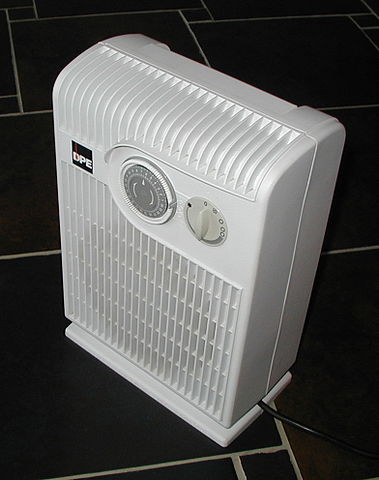Heater

Space heaters are small, portable heating devices that are generally used when the main heating system in a building is inadequate. Overall, if only one room needs heating, space heaters are a more cost effective solution.[2] Space heaters come in a number of different designs and can run on electricity, propane, natural gas, or kerosene.
Space heaters work by utilizing convection or radiant heating. Radiant heaters emit infrared radiation into the room that directly heats objects and people who are close to them. These heaters are a better choice if only heating one room for a couple of hours and everyone will be within sight of the heater. In addition, this type of heater can be more efficient as they directly heat the occupant rather than heating the entire room (which may be unnecessary).[2]
Although plug-in space heaters are common, there are other portable options that can warm a single room in essentially the same way. Some of these include small portable electrical fireplaces or baseboard mounted heating units which are also commonly used in addition to a homes furnace or boiler.[3] Overall, supplementary heating in a home is commonplace as it is natural for some rooms to have more use or be colder than others. In 2007, it was estimated that 42% of Canadian households used some form of secondary heating.[3]
Types
There are a couple of different styles of space heater, some that heat by convection and some that heat by radiant heat. Depending on the size of the room that is to be heated and how much it needs to be heated, a different type may be most effective. Whichever type is chosen, be sure to select the heater that is the proper size for the room that is to be heated. Buying an oversized heater is a fire hazard and does not contribute greatly to warming a room. In fact, an oversized heater could heat a room to uncomfortable temperatures and should be avoided. Some of the basic types of space heaters are:[2]
- Vented Combustion Heaters: This type of space heater is suitable for inside use, but is designed to be permanently located next to an outside wall so that a flue can be installed to the outside. Some units pull air from the outside, and these units are called "sealed combustion" heaters which are much safer to operate than other types. Sealed units also operate more efficiently as they take air from outside.
- Unvented Combustion Heaters: This type of space heater is not recommended for inside use as they introduce harmful by-products of combustion into the home. These by-products include carbon monoxide, nitrogen oxides, and water vapour. In addition. this type depletes air inside the space.
- Electric Heaters: This type of heater is more expensive than combustion heaters, but they are unvented and safe to operate inside the home. Electric heaters do not pose indoor air quality concerns, however they are still a burn and fire hazard. Some convection space heaters incorporate a heat transfer liquid, such as an oil, that is heated by an electrical element and stores this heat. This allows the heater to provide a more constant heat source.
Safety
Although effective at heating small spaces, space heaters can pose a safety concern. The major risks when using space heaters are burns and fire. To minimize these risks, ensure to follow manufacturer's guidelines and the following recommendations. For combustion space heaters, use only the approved fuel—and never gasoline. Additionally, do not overfill the heater or fill it when it is still hot. Store the fuel outdoors to minimize the risk of starting a fire inside the home. It is also important to have vented space heaters professionally inspected to ensure that the venting is working properly to minimize the risk of carbon monoxide entering the home. When using an electric space heater, plug it directly into the wall or use a small heavy duty cord. Moreover, some units are available with a tip-over safety switch that shuts the unit off if it tips over to minimize any risk of fire.[2] When using heaters, ensure that they are not placed where a person could bump their leg into the unit and burn it, ensure children and pets do not have easy access to it to prevent them from burning themselves, keep the heaters away from drapes or loose fabrics, and do not cover the heater to minimize the risk of fire.
For Further reading
- Insulation
- Home heating
- Heating vent
- Home energy use
- Or explore a random page
References
- ↑ Wikimedia Commons. (May 20, 2015). Fan Heater 2005 [Online]. Available: http://commons.wikimedia.org/wiki/File:Fan_heater_2005.jpg#/media/File:Fan_heater_2005.jpg
- ↑ 2.0 2.1 2.2 2.3 Energy.gov. (May 20, 2015). Portable Heaters [Online]. Available: http://energy.gov/energysaver/articles/portable-heaters
- ↑ 3.0 3.1 National Resources Canada. (May 21, 2015). 2007 Survey of Household Energy Use (SHEU-2007) – Summary Report [Online]. Available: http://oee.nrcan.gc.ca/publications/statistics/sheu-summary07/space-heating.cfm

